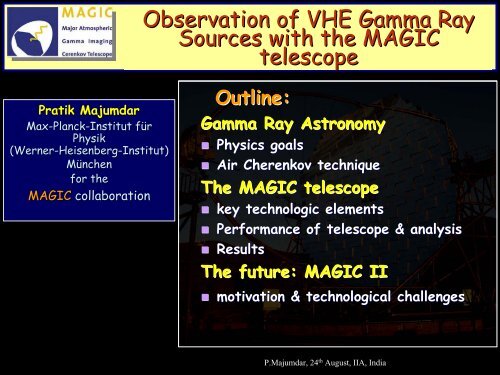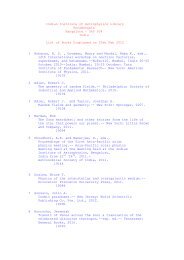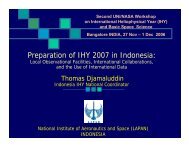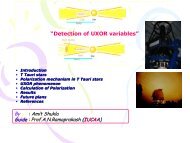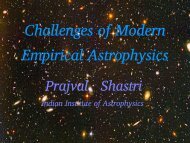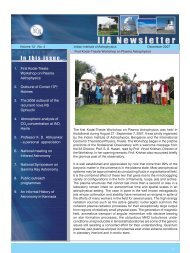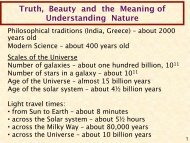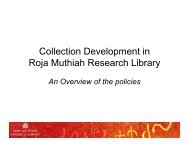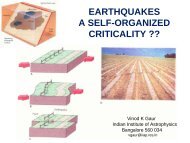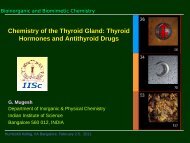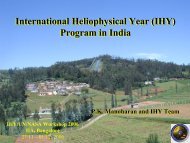Observation of VHE Gamma Ray Sources with the MAGIC telescope
Observation of VHE Gamma Ray Sources with the MAGIC telescope
Observation of VHE Gamma Ray Sources with the MAGIC telescope
You also want an ePaper? Increase the reach of your titles
YUMPU automatically turns print PDFs into web optimized ePapers that Google loves.
<strong>Observation</strong> <strong>of</strong> <strong>VHE</strong> <strong>Gamma</strong> <strong>Ray</strong><br />
<strong>Sources</strong> <strong>with</strong> <strong>the</strong> <strong>MAGIC</strong><br />
<strong>telescope</strong><br />
Pratik Majumdar<br />
Max-Planck<br />
Planck-Institut<br />
für<br />
Physik<br />
(Werner-Heisenberg-Institut)<br />
München<br />
for <strong>the</strong><br />
<strong>MAGIC</strong> collaboration<br />
Outline:<br />
<strong>Gamma</strong> <strong>Ray</strong> Astronomy<br />
• Physics goals<br />
• Air Cherenkov technique<br />
The <strong>MAGIC</strong> <strong>telescope</strong><br />
• key technologic elements<br />
• Performance <strong>of</strong> <strong>telescope</strong> & analysis<br />
• Results<br />
The future: <strong>MAGIC</strong> II<br />
• motivation & technological challenges<br />
P.Majumdar, 24 th August, IIA, India
Multiwavelength Astronomy<br />
Cosmic microwave background, ~3 mm<br />
1 EeV<br />
10<br />
18<br />
eV<br />
1 PeV 1 TeV 1 GeV 1 MeV 1 keV<br />
10 15 eV 10 12 eV 10 9 eV 10 6 eV 10 3 eV 1 eV 10 -3 eV 10 -6 eV 10 -9 eV 10 -12 eV 10 -15 eV<br />
1 mm<br />
UHE<br />
<strong>VHE</strong><br />
HE<br />
γ rays<br />
X<br />
UV<br />
visible<br />
IR<br />
radio<br />
-18<br />
10 m<br />
1 am<br />
10 -15 m<br />
1 fm<br />
10 -12 m<br />
1 pm<br />
10 -9 m<br />
1 nm<br />
10 -6 m<br />
1 µ m<br />
10 -3 m<br />
1 mm<br />
1 m<br />
10 3 m<br />
1 km<br />
300 MHz<br />
300 GHz 300 kHz<br />
10 6 m<br />
1 Mm<br />
satellites<br />
100 km<br />
40 km<br />
20 km<br />
γ<br />
EAS<br />
rockets<br />
Cherenkov<br />
<strong>telescope</strong>s<br />
fluorescence<br />
detectors<br />
particle detectors<br />
balloons<br />
Earth surface<br />
N2, O2, O 3 , O<br />
optical<br />
<strong>telescope</strong>s<br />
H2O<br />
CO 2<br />
radio <strong>telescope</strong>s<br />
50% <strong>of</strong> incident<br />
radiation absorbed<br />
P.Majumdar, 24 th August, IIA, India
Cosmic Radiation<br />
original motivation for search<br />
for TeV gamma radiation<br />
discovered 1912<br />
by Victor Hess<br />
composition:<br />
-mainly protons<br />
energy spectrum<br />
-power law (~ E -2.7 ) over<br />
very large energy range<br />
P.Majumdar, 24 th August, IIA, India
Origin <strong>of</strong><br />
cosmic radiation <br />
apparent<br />
source<br />
direction<br />
charged<br />
particle<br />
<strong>Gamma</strong><br />
nucleus + X -> π + X‘<br />
π 0<br />
-> γγ<br />
P.Majumdar, 24 th August, IIA, India
Physics Motivation for <strong>MAGIC</strong><br />
Pulsars<br />
Origin <strong>of</strong><br />
Cosmic <strong>Ray</strong>s<br />
AGNs<br />
Cosmological<br />
γ-<strong>Ray</strong> Horizon<br />
Quantum Gravity<br />
SNRs<br />
GRBs<br />
P.Majumdar, 24 th August, IIA, India<br />
Dark Matter
High energy γ-ray astronomy:<br />
• youngest astronomic discipline<br />
• First significant measurement <strong>of</strong> TeV<br />
γ-ray emission from Crab Nebula by<br />
Whipple <strong>telescope</strong> in 1989<br />
TeV <strong>Gamma</strong>-rays<br />
(10 12 eV)<br />
QuickTime and a<br />
TIFF (Uncompressed) decompressor<br />
are needed to see this picture.<br />
QuickTime and a<br />
TIFF (Uncompressed) decompressor<br />
are needed to see this picture.<br />
P.Majumdar, 24 th August, IIA, India
Imaging<br />
Air<br />
Cherenkov<br />
Telescopes<br />
<strong>Gamma</strong><br />
ray<br />
Particle<br />
shower<br />
~ 10 km<br />
Cherenkov light Image <strong>of</strong> particle<br />
shower in <strong>telescope</strong> camera<br />
Cherenkov light<br />
~ 120 m<br />
~ 1 o<br />
Intensity => Energy<br />
Orientation => Arrival direction<br />
Shape => Primary particle<br />
P.Majumdar, 24 th August, IIA, India
Background Rejection<br />
gamma shower<br />
Main Background:<br />
- Cosmic <strong>Ray</strong> (hadron)<br />
showers<br />
raw image<br />
cleaned image<br />
hadron shower (background)<br />
- >10 4 times more<br />
numerous than γ-ray<br />
showers<br />
- Reject based on shower<br />
shape<br />
P.Majumdar, 24 th August, IIA, India
Standard “Hillas” Analysis<br />
LENGTH<br />
WIDTH<br />
On data<br />
Alpha Plot<br />
DIST<br />
α<br />
Off data<br />
Background rejection <strong>with</strong><br />
multidimensional cuts on<br />
Hillas parameters:<br />
Length, Width, Dist, Alpha<br />
Hadron background:<br />
-isotropic<br />
- flat Alpha distribution<br />
<strong>Gamma</strong>s:<br />
- excess in source direction<br />
P.Majumdar, 24 th August, IIA, India
Current generation IACTs<br />
VERITAS<br />
(USA & England)<br />
4 (7) <strong>telescope</strong>s<br />
10 meters Ø<br />
VERITAS<br />
Montosa<br />
Canyon,<br />
Arizona<br />
<strong>MAGIC</strong><br />
<strong>MAGIC</strong><br />
(Germany, Spain, Italy)<br />
1 <strong>telescope</strong> 17 meters Ø<br />
Roque de<br />
los Muchachos, Canary<br />
Islands<br />
H.E.S.S.<br />
Windhoek,<br />
HESS Namibia<br />
(Germany & France)<br />
4 <strong>telescope</strong>s<br />
12 meters Ø<br />
TACTIC<br />
CANGAROO<br />
(Australia & Japan)<br />
4 <strong>telescope</strong>s 10 meters Ø<br />
Woomera,<br />
Australia<br />
P.Majumdar, 24 th August, IIA, India
Wave front Sampling<br />
Cerenkov Telescopes<br />
P.Majumdar, 24 th August, IIA, India
Success <strong>of</strong> Cherenkov Telescopes (E > 300 GeV)<br />
Discovery <strong>of</strong> several (o(10)) TeV γ-ray<br />
sources ( upto 2003-2004)<br />
2004)<br />
- galactic sources<br />
(shell type SNR, Plerions)<br />
– extra-galactic sources (AGNs)<br />
Cosmic <strong>Ray</strong> origin not resolved ()<br />
But …<br />
Where are all <strong>the</strong> sources seen by<br />
EGRET <br />
- effective area ~ 1 m 2<br />
- E < 10 GeV,<br />
- 271 sources (171 unidentified)<br />
P.Majumdar, 24 th August, IIA, India
The unexplored spectrum gap<br />
• Strong cut<strong>of</strong>f in γ-spectrum for<br />
10 Gev < E < 300 GeV<br />
• The energy range between E ~ 10GeV<br />
(satellites) and E ~ 100 GeV (IACTs)) is still<br />
unexplored<br />
=> Push down E thr <strong>of</strong> IACTs<br />
P.Majumdar, 24 th August, IIA, India
Present Status <strong>of</strong> <strong>VHE</strong> sources<br />
Mkn421<br />
H1426<br />
90<br />
1ES1218<br />
M87<br />
Mkn180<br />
Mkn501<br />
PG1553<br />
1ES1101<br />
1ES1959<br />
180<br />
1ES2344BLLac<br />
-180<br />
3C66A<br />
PKS2005<br />
PKS2155<br />
H2356<br />
-90<br />
NGC253<br />
• Many new galactic and extragalactic sources being<br />
discovered <strong>with</strong> current generation <strong>telescope</strong>s<br />
P.Majumdar, 24 th August, IIA, India
The <strong>MAGIC</strong> <strong>telescope</strong><br />
• Largest Imaging Air<br />
Cherenkov Telescope<br />
for γ-ray astronomy<br />
(17 m mirror dish)<br />
Canary Island La Palma<br />
2200 m asl<br />
• low energy trigger<br />
threshold<br />
E γ<br />
= 50-60<br />
GeV<br />
• fast repositioning<br />
t R<br />
100 physicists, 18 institutes, 11 countries:<br />
Barcelona IFAE, Barcelona UAB, HU Berlin, Crimean Observatory, U.C. U<br />
Davis,<br />
U. Dortmund, U. Lodz, , UCM Madrid, INR Moscow, MPI München,<br />
INFN/ U. Padua, INFN/ U. Siena, S<strong>of</strong>ia, Tuorla Observatory,<br />
Yerevan Phys. Institute, INFN/ U. Udine, , U. Würzburg, , ETH ZürichZ<br />
P.Majumdar, 24 th August, IIA, India
<strong>MAGIC</strong>: a pioneering <strong>telescope</strong><br />
The key parameters <strong>of</strong> <strong>the</strong> <strong>MAGIC</strong> <strong>telescope</strong>:<br />
• 17 m ∅ reflector (240 m 2 )<br />
• carbon fibre frame<br />
• Active mirror control<br />
• 577 pixel, ~3.5° camera<br />
• Analogue optical signal<br />
transport via fibres<br />
• 3-level trigger system<br />
• Ultra-fast readout<br />
• Trigger threshold 50 GeV<br />
Energy Res. 20% (30%)<br />
@ 1 TeV (100 GeV)<br />
Sensitivity: 2.5 % Crab/50 hrs 5 sigma<br />
P.Majumdar, 24 th August, IIA, India
• October 2003: Inauguration<br />
Status <strong>of</strong> <strong>MAGIC</strong><br />
• until August 2004: Commissioning<br />
• July 2004: Installation <strong>of</strong> last<br />
Mirrors<br />
• September 2004:<br />
Start <strong>of</strong> regular data-taking<br />
taking<br />
- data-taking taking efficiency gradually<br />
improving, reaching 80-90% in<br />
January 2005 (nice wea<strong>the</strong>r)<br />
• February 2005:<br />
- wea<strong>the</strong>r is not always nice<br />
• Data taking smooth in 2006<br />
• Completed Cycle 1 data taking<br />
no data-taking possible<br />
for 2 months<br />
P.Majumdar, 24 th August, IIA, India
Calibration<br />
Standard calibration<br />
• light pulses illuminating<br />
camera uniformly<br />
• allows calibration in PEs<br />
Muon calibration<br />
• select set <strong>of</strong> clean muons hitting<br />
mirror dish (2.3 Hz)<br />
• comparison <strong>of</strong> measured and<br />
expected muon signal<br />
• allows absolute calibration <strong>of</strong><br />
photon collection efficiency <strong>of</strong><br />
detector (mirror + PMTs + ..)<br />
+ data<br />
+ MC<br />
P.Majumdar, 24 th August, IIA, India
<strong>MAGIC</strong> HIGHLIGHTS<br />
LSI+61 303<br />
Galactic Center<br />
Crab Nebula<br />
HESS J1834 Micro-Quasar<br />
SZA & LZA HESS J1813<br />
New Source Mrk421 (0.031)<br />
Mrk501 (z=0.034)<br />
Mrk180 (0.045)<br />
New source<br />
1ES1959 (0.047)<br />
1ES1218 (z=0.18)<br />
New Source<br />
PG 1553 (Z>0.25)<br />
New source<br />
P.Majumdar, 24 th August, IIA, India
Crab Nebula used as a<br />
Calibration source<br />
Crab Nebula SED<br />
Sensitivity<br />
2.5% Crab in 50 hours/5sigma<br />
E 2<br />
P.Majumdar, 24 th August, IIA, India
Search for Pulsations in <strong>VHE</strong> data<br />
‣ Most energetic pulsar (L m = 5•10 38<br />
erg s -1 )<br />
‣ Only pulsar whose pulsed emission<br />
phase is <strong>the</strong> same in all wavelengths.<br />
NO PULSATION DETECTED<br />
AT ENERGIES > 100 GeV<br />
Limit to Exponential cut-<strong>of</strong>f<br />
E cut < 60 GeV<br />
P.Majumdar, 24 th August, IIA, India
Monte Carlo: comparison <strong>with</strong> data<br />
MC γ<br />
Data: ON (gammas+hadrons) - Off(hadrons)<br />
P.Majumdar, 24 th August, IIA, India
Galactic Center<br />
Stars around center<br />
• Very turbulant region<br />
• Central black hole 3.3 10 6 M S<br />
• fast X-ray X<br />
flares (in hours)<br />
• Several SNRs close<br />
• Neutralino annihilation <br />
• Controversial TeV spectrum<br />
Black hole 3.3 10 6 M s<br />
Radio<br />
90 cm<br />
P.Majumdar, 24 th August, IIA, India
• Analysisthreshold ~400 GeV<br />
• Spectral Index 2.2 ± 0.2<br />
• No significant variability<br />
• Morphology and spectrum under<br />
study:<br />
only neutralino anihilation unlikely<br />
(no cut<strong>of</strong>f in spectrum mn > 12<br />
TeV)<br />
• Zenithangle 58°-62<br />
62°<br />
• TeV gamma emission spatially<br />
consistent <strong>with</strong> Sgr A* and Sgr A<br />
East<br />
• Compatible <strong>with</strong> point source<br />
P.Majumdar, 24 th August, IIA, India
HESSJ 1813-178<br />
178<br />
Section <strong>of</strong> shell spatially<br />
coincident <strong>with</strong><br />
SNR G12.82-0.02<br />
Zenithangle: 47°-54°<br />
Threshold: 400 GeV<br />
Index 2.15 ± 0.3<br />
Hadronic Acceleration <br />
P.Majumdar, 24 th August, IIA, India
VLA: 20 cm radio<br />
HESS1834-087<br />
Molecular clouds: 13 CO data<br />
Coincident <strong>with</strong><br />
SNR G 23.3-0.3 (W41)<br />
Source clearly extended<br />
Index -2.5 ± 0.2 steep<br />
Indication for interaction<br />
<strong>with</strong> dense cloud<br />
Hadronic acceleration <br />
P.Majumdar, 24 th August, IIA, India
• Microquasars:<br />
• Binary systems<br />
displaying relativistic<br />
radio jets<br />
• Compact object<br />
Neutron Star or a<br />
Black Hole<br />
• Laboratories <strong>of</strong> jet<br />
physics<br />
• Possible<br />
contributors to<br />
galactic cosmic rays<br />
Microquasars<br />
Disc<br />
+ corona <br />
X<br />
<strong>the</strong>rm +<br />
non <strong>the</strong>rm<br />
Large scale ejection<br />
Radio & X<br />
gamma<br />
Interaction <strong>with</strong><br />
environment<br />
Compacts jets<br />
Radio IR<br />
X<br />
gamma<br />
(synchrotron)<br />
P.Majumdar, 24 th August, IIA, India
LS I +61 303 at Very High Energies<br />
• <strong>MAGIC</strong> has observed LS I +61 303 for 54 hours from November<br />
2005 to March 2006 (6 orbital cycles)<br />
Albert et al. 2006, Science<br />
• A point-like source (E>200GeV) detected <strong>with</strong> significance <strong>of</strong> ~9σ<br />
• Position: RA=2 h 40 m 34 s , DEC=61°15’ 25” [±0.4’ (stat), ±2’ (syst)] in<br />
agreement <strong>with</strong> LSI position ⇒ identification <strong>of</strong> γ-ray source<br />
• The source is quiet at periastron passage and at relatively high<br />
emission level (16% Crab Nebula flux) at later phases [0.5-0.7]<br />
P.Majumdar, 24 th August, IIA, India
LS I +61 303: <strong>the</strong> film<br />
Albert et al. 2006<br />
• The average emission has a maximum at phase 0.6.<br />
• Search for intra-night flux variations (observed in radio and x-rays)<br />
yields negative result<br />
• Marginal detections occur at lower phases. We need more<br />
observation time at periastron passage<br />
• Parts <strong>of</strong> <strong>the</strong> orbit not covered due to similarities between orbital<br />
period (26.5 days) and Moon period<br />
P.Majumdar, 24 th August, IIA, India
• <strong>MAGIC</strong> has observed<br />
LSI during 6 orbital cycles<br />
• A variable flux<br />
(probability <strong>of</strong> statistical<br />
fluctuation 3×10 -5 )<br />
detected<br />
• Marginal detections at<br />
phases 0.2-0.4<br />
• Maximum flux<br />
detected at phase 0.6-0.7<br />
<strong>with</strong> a 16% <strong>of</strong> <strong>the</strong> Crab<br />
Nebula flux<br />
• Strong orbital<br />
modulation ⇒ <strong>the</strong><br />
emission is produced by<br />
<strong>the</strong> interplay <strong>of</strong> <strong>the</strong> two<br />
objects in <strong>the</strong> binary<br />
• No emission at<br />
periastron, two maxima in<br />
consecutive cycles at<br />
similar phases ⇒ hint <strong>of</strong><br />
periodicity!<br />
Flux variability<br />
Albert et al. 2006<br />
P.Majumdar, 24 th August, IIA, India
Contemporaneous radio observations<br />
Albert et al. 2006<br />
• We perform contemporaneous radio observations (Ryle<br />
<strong>telescope</strong> 15GHz) during <strong>the</strong> last observed orbital cycle<br />
• Two maxima are detected: just before periastron and higher at<br />
phase 0.7<br />
• TeV peak observed before <strong>the</strong> radio <br />
•The absence <strong>of</strong> a spectral feature between 10 and 100 keV goes against<br />
an accretion scenario !!!!<br />
P.Majumdar, 24 th August, IIA, India
Extragalactic Objects<br />
• Active Galactic Nuclei (AGN) and blazars<br />
• <strong>MAGIC</strong><br />
• Markarian 421, z=0.030<br />
• Markarian 501, z=0.034<br />
• Markarian 180, z=0.045<br />
• 1ES1959+650, z=0.047<br />
• 1ES1218+304, z=0.182<br />
• PG1553+113, z>0.09<br />
redshift<br />
P.Majumdar, 24 th August, IIA, India
Mkn 421 (z=0.030)<br />
spectrum<br />
• Dec 2004 – Apr 2005<br />
• 25.6 h, over 7000 excess events<br />
• Energy threshold: 150 GeV<br />
lightcurve<br />
TeV<br />
X-ray<br />
TeV-X-raycorrelation<br />
optical<br />
optical<br />
ApJ submitted, astro-ph/0603478<br />
P.Majumdar, 24 th August, IIA, India
Mkn 421 (z=0.030)<br />
SED<br />
SSC constraints<br />
log(B)<br />
A<br />
B<br />
C<br />
log(B)<br />
D<br />
E<br />
F<br />
• In case <strong>of</strong> 1-day<br />
variability scale, <strong>the</strong><br />
model provides similar<br />
parameters as from <strong>the</strong><br />
1994 flare: D=9, B=0.3G<br />
log(D)<br />
log(D)<br />
astro-ph/0603478<br />
P.Majumdar, 24 th August, IIA, India
• June – July 2005<br />
• 23.1 h, over 85 σ, over 14000<br />
excess events<br />
• Analysis threshold: 150 GeV<br />
Mkn 501 (z=0.034)<br />
TeV<br />
X-ray<br />
TeV-opticalcorrelation<br />
TeV/X-raycorrelation<br />
optical<br />
P.Majumdar, 24 th August, IIA, India
Mkn 501 (z=0.034)<br />
• Flare on 9 July 2005<br />
• Doubling time less than 5 min.<br />
• Spectrum shape changes<br />
<strong>with</strong>in minutes<br />
• IC peak detected<br />
P.Majumdar, 24 th August, IIA, India
Mkn 180 (z=0.045)<br />
• Whipple: F (>300GeV)<br />
1.5TeV)<br />
200GeV) = 11%C.U.,<br />
steep index: -3.3 ± 0.7<br />
spectrum<br />
θ 2 plot<br />
Accepted in ApJL<br />
sky plot<br />
SED<br />
P.Majumdar, 24 th August, IIA, India
1ES1959+650 (z=0.047)<br />
• Blazar famous for <strong>the</strong><br />
orphan flare in 2002<br />
• <strong>MAGIC</strong>: Significant signal<br />
in only 6h <strong>of</strong> effective obs.<br />
ApJ, 639 (2006), 761<br />
• Light curve: flaring or<br />
quiescent state<br />
• Current multiwavelength<br />
data not enough to<br />
distinguish between<br />
hardronic and leptonic<br />
models<br />
• More data in pipeline<br />
TeV<br />
X-ray<br />
P.Majumdar, 24 th August, IIA, India
1ES1218+304 (z=0.182)<br />
• Whipple: F (>350GeV)<br />
750GeV)<br />
120GeV) = 13% C.U.,<br />
index: -3.0 ± 0.4<br />
spectrum<br />
θ 2 plot<br />
TeV lightcurve<br />
P.Majumdar, 24 th August, IIA, India
1ES1218+304 (z=0.182)<br />
• Is it possible to derive EBL constraints from <strong>the</strong> 1ES1218 spectrum<br />
• Assuming 6 different EBL realizations, all reconstructed de-absorbed spectra<br />
do not contradict <strong>the</strong> rising slope dN/dE ∼ E -Γ , Γ > 1.5<br />
P.Majumdar, 24 th August, IIA, India
PG1553+113 (z>0.09)<br />
• Observed 18.8h in 2005-06<br />
• H.E.S.S.: 4.0σ evidence<br />
(A&A 448L (2006), 43)<br />
• <strong>MAGIC</strong>: astro-ph/0606161<br />
• 8.8σ, firm detection.<br />
Alpha plot<br />
lightcurve<br />
spectrum<br />
P.Majumdar, 24 th August, IIA, India
PG1553+113 (z>0.09)<br />
• Put HESS/<strong>MAGIC</strong><br />
Spectrum<br />
toge<strong>the</strong>r<br />
• Apply correction<br />
factor to account<br />
for systematics<br />
• Method 1:<br />
Loglikelihood test<br />
between power<br />
law and broken<br />
power law<br />
• Method 2:<br />
modified run test;<br />
probability <strong>of</strong> <strong>the</strong><br />
given distribution<br />
<strong>of</strong> points around<br />
<strong>the</strong> fitted power<br />
law<br />
Preliminary<br />
result, using <strong>the</strong><br />
method:<br />
z < 0.42<br />
P.Majumdar, 24 th August, IIA, India
First year operation (Sep04-Sep05): Sep05): <strong>Gamma</strong>-<strong>Ray</strong> Bursts<br />
# GRB Event<br />
Satellite<br />
Onset<br />
[UTC]<br />
Δt alert<br />
[sec]<br />
Δt obs.<br />
[sec]<br />
θ<br />
[deg]<br />
z<br />
1 GRB050408<br />
2 GRB050421<br />
3 GRB050502<br />
4 GRB050505<br />
5 GRB050509<br />
6 GRB050509<br />
7 GRB050528<br />
8 GRB050713<br />
9 GRB050904<br />
HETE 16:22:50 14 3138 48 1.23<br />
SWIFT 04:11:52 58 112 52<br />
SWIFT 02:14:18 18 990 33 3.79<br />
SWIFT 23:22:21 540 793 50 4.27<br />
SWIFT 01:46:29 16 115 57<br />
SWIFT 04:00:19 15 368 69 0.23<br />
SWIFT 04:06:45 43 77 52<br />
SWIFT 04:29:02 04:20:02 13 40 49<br />
SWIFT 01:51:44 82 92 20 6.29<br />
Drive system<br />
improvement<br />
On 13 July 2005 <strong>MAGIC</strong><br />
pointed to a GRB only 40 s<br />
after prompt emission<br />
P.Majumdar, 24 th August, IIA, India
Light curve GRB050713, as observed <strong>with</strong> <strong>MAGIC</strong><br />
Published in ApJ Letters No significant excess above 175 GeV<br />
P.Majumdar, 24 th August, IIA, India
Extension <strong>of</strong> <strong>MAGIC</strong> => <strong>MAGIC</strong> II<br />
• The <strong>MAGIC</strong> collaboration has started to build a<br />
second <strong>telescope</strong><br />
<strong>MAGIC</strong> II will<br />
• increase <strong>the</strong><br />
sensitivity <strong>of</strong> <strong>the</strong><br />
observatory<br />
• allow to fur<strong>the</strong>r<br />
push for a lower<br />
energy threshold<br />
<strong>MAGIC</strong>-I<br />
<strong>MAGIC</strong>-II<br />
II<br />
P.Majumdar, 24 th August, IIA, India
Advantages <strong>of</strong> <strong>MAGIC</strong> II<br />
• Coincidence / Stereo mode<br />
• better sensitivity<br />
• far and faint sources<br />
• time variability sources<br />
• better angular resolution (source location / identification)<br />
• high purity gamma selection (control <strong>of</strong> systemactics)<br />
• Parallel mode<br />
• observe 2 objects simultaneously (e.g. search for flaring<br />
• Testbench for new technologies<br />
• higher Quantum Efficiency Camera<br />
=> lower energy threshold<br />
• fast digitization<br />
2 GHz FADC => background reduction<br />
(e.g. search for flaring AGNs)<br />
P.Majumdar, 24 th August, IIA, India
<strong>MAGIC</strong> II Monte Carlo Studies<br />
•Stereo Stereo Analysis:<br />
• observe shower simultaneously<br />
<strong>with</strong> 2 <strong>telescope</strong>s<br />
improve:<br />
• shower reconstruction<br />
(energy, arrival direction)<br />
• background rejection<br />
P.Majumdar, 24 th August, IIA, India
<strong>MAGIC</strong> II: “improved Clone”<br />
• Clone overall design / <strong>telescope</strong> structure <strong>of</strong> <strong>MAGIC</strong> I<br />
=> save time and money for redesign<br />
• Employ improved technologies for key elements:<br />
• High(er) ) Quantum Efficiency Camera<br />
(=> lower energy threshold )<br />
• HPDs (QE up to 50%)<br />
• long term: SiliconPMs<br />
(QE up to 60 - 80% possible)<br />
• Fast 2Gsamples/sec digitization<br />
• multiplexer FADC (planned already for<br />
<strong>MAGIC</strong> I)<br />
• switch capacitors<br />
(fast & flexible solution ready end 2006)<br />
241 m 2 -> 286 m 2 !!!<br />
P.Majumdar, 24 th August, IIA, India
<strong>MAGIC</strong> II: Sensitivity gain<br />
using Stereo Analysis<br />
• better background rejection<br />
down to low energies<br />
• increase sensitivity by factor 2<br />
=> reduce observation time<br />
by factor 4<br />
stereo<br />
P.Majumdar, 24 th August, IIA, India
Conclusions<br />
• <strong>MAGIC</strong> is a successful pioneering <strong>telescope</strong> for<br />
low energy gamma ray astronomy producing quality results<br />
• Successfully completed first observation cycle in May 2006<br />
• Telescope Performance studied and well understood<br />
• 1 Galactic source and 3 extragalactic sources discovered apart from<br />
observing known sources<br />
• A second improved <strong>telescope</strong> is being built to<br />
• Increase sensitivity<br />
• Fur<strong>the</strong>r lower energy/analysis threshold<br />
35<br />
!!!! Very exciting time for gamma-ray astronomy !!!!<br />
P.Majumdar, 24 th August, IIA, India


